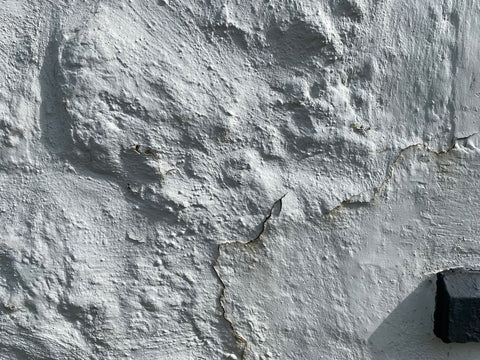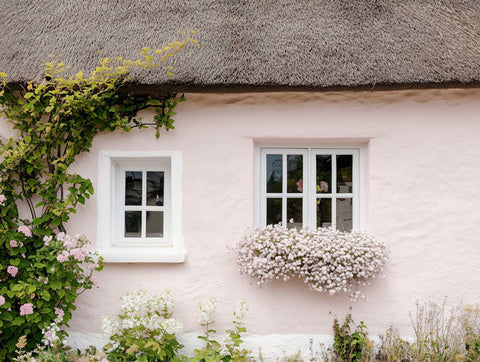Lime plaster was commonly used on properties built in the UK pre 1914 and was still in use for new builds until the 1950s. This type of wall finish was about more than just form - it also had an important function.
Older properties tended to be constructed with solid walls, rather than the cavity wall method in more modern properties.

Lime plaster isn’t just a traditional finish, it has an important function in many older homes. This breathable substrate helps walls handle moisture properly. Older solid walls naturally take in a little moisture and then let it out again.
A breathable plaster is an integral part of keeping solid walls damp free, as it allows moisture to pass through. When lime is swapped for dense, modern coatings the wall can’t breathe as it should, and that is when damp, flaky paint and even structural damage can follow.
What Is Lime Plaster?
Lime plaster is a traditional building material made from lime, sand, and other natural fibres like horsehair.
This type of plaster creates a highly breathable substrate which allows moisture to escape from the structure of older properties with solid walls. When dried, it has a flexible finish which allows the building to move slightly without causing cracks in internal walls.
Why Older Houses Used Lime
Lime plaster was used because it compliments the way traditional buildings breathe and helps keep homes damp free.
It lets moisture escape, copes with small movements without cracking, and its natural alkalinity helps keep mould growth at bay in damp areas like cellars.
Benefits of Using Lime Plaster
If you are renovating an older home, you may wish to consider reinstating lime plaster that’s been replaced with more modern cement based plasters. It has many well documented benefits and is the most suitable plaster for heritage properties with solid walls.
- Breathability - Lime allows water vapour to move through the wall so it can dry naturally. Pair it with breathable paints like clay, silicate and lime based paints to maintain breathability within your home.
- Damp Prevention - By allowing moisture to escape and tolerating salts, lime helps prevent flaking paint, blown plaster and mould infestations.
- Flexible, Repairable Finish - Lime accommodates minor movement, so hairline cracks are less likely and small defects can often be patched.
- Indoor Air Quality - Lime is naturally alkaline, which makes it less welcoming to mould. Finished with mineral, low VOC paints, it supports fresher, healthier indoor air.
Replacing Lime Plaster with Cement & Gypsum Plasters
Dense gypsum and cement plasters trap moisture in the building structure. In a solid wall that often means trapped damp, salt staining, blistering paint and brittle cracks.
Things can look fine straight after replastering, then problems creep back because the wall is retaining moisture which cannot escape. Many owners of heritage properties are choosing to reinstate lime based plasters as a result of this.
Practical Tips If You Plan to Reinstate Lime
Before you reinstate lime plaster, make sure you’ve identified and remedied all sources of water ingress from your property.
Ensure common causes of damp such as leaky gutters, poor drainage around your property, loose tiles, and plumbing issues have been addressed.
Once your lime plaster has been applied and cured, paint can be applied. It's important to use a highly breathable paint so the lime plaster can breathe and regulate moisture within your home.
What Does Paint Breathability Mean?
Breathability is a measure of how easily water vapour can move through the paint and escape, leaving the substrate dry.
Many technical data sheets list an Sd value. Low Sd values mean greater paint breathability.
Many paints claim to be breathable, using language which suggests moisture can move through the finish. However, some are not suitable for older houses which need true breathability meaning it’s vital to check the TDS.
If paint ingredients mention acrylic, vinyl, or claim to be scrubbable - they are unlikely to be suitably breathable for lime plasters.
Best Paints for Lime Plaster
Lime plaster works best with paint which shares its breathable characteristics. Using modern plastic based paints will cause moisture to become trapped.
Limewash - Slaked lime and water with mineral pigments. Soaks into the plaster and bonds with it, so the two become one breathable surface.
Lime Based Paint - a more modern and hard wearing paint which shares many of the ingredients of lime wash, but with more effective binders.
Silicate Paint - Mineral potassium silicate binder that chemically bonds to lime and other mineral surfaces. Very durable, matte and breathable for inside and out, once the plaster has cured.
Clay Paint - Clay and mineral fillers in a natural binder system. Soft, flat look that helps regulate indoor humidity.
Casein Paint - Milk-protein binder with minerals. Traditional, matte and breathable with a gentle, heritage feel.
Steer clear of plastic based emulsions that promise high washability. They block vapour and can drive moisture back into the wall.
Read more:
What is Limewash | Clay Paint | Painting on Lime Plaster | Casein | Lime Paint | Best breathable paint for cellar walls | Breathable paint for damp walls | Breathable paint for old houses
Should You Reinstate Lime Plaster?
Yes in many cases, especially in listed buildings, rooms with stubborn damp or where dense coatings have failed more than once.
Full reinstatement is best over large areas. Patch repairs are fine where original lime is still doing its job and breathability continues across the surface. Use trades who understand heritage work.
Need Personalised Advice on Paint for Lime Plaster?
Not sure which paint is right for your project? Our team can help you choose the perfect eco-friendly finish for your walls. Get in touch for expert advice, and we’ll send you a free paint chart so you can explore our paint colours at home. You can also buy a reusable paint colour swatch.




